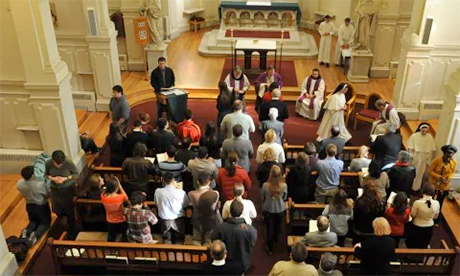Will people come back?
That’s the question on the minds of parish leaders in the 17,000 American Catholic churches as the U.S. begins a return to a new normal post-pandemic life.
There are no guarantees, say Marti Jewell and Mark Mogilka, authors of “Open Wide the Doors to Christ: A Study of Catholic Social Innovation for Parish Vitality,” just published by Foundations and Donors Interested in Catholic Activities, or FADICA, an organization that promotes best practices for church managers.
The two interviewed and studied two dozen parishes across the country, selected because of their reputation of vitality, along with more than 65 ministry leaders. Each parish in the study remained anonymous in the interest of providing candid input.
Vitality, noted the authors, is a somewhat amorphous concept. But you know it when you see it, Mogilka told NCR in a June 9 Zoom interview, with Mogilka participating from his home in Green Bay, Wisconsin, and Jewell from Richmond, Virginia.
“You can feel it, it’s tangible. There’s an excitement. People are excited to meet you,” said Mogilka.
Parishioners in vibrant parishes are likely to stay later on Sundays and greet newcomers.
The parish bulletin contains information about activities that go well beyond weekends, including social service outreach.
The result is often like that experienced at a superb restaurant: word gets out from enthusiastic patrons willing to tell their friends and neighbours about their spiritual and social ministry experiences.
The model of parishioners ensconced in a tight community, keeping the rest of the world away, is fading away.
Whether or not Catholics come back after the pandemic will depend much upon what their parishes were like before the pandemic struck.
What’s clear, they said, is that change will be needed. “Pastors have to let go of ‘they will go back and we’ll do it as we did,’ ” Jewell told NCR.
Mogilka, a consultant for Meitler Inc., a church planning and consulting firm, is more definitive.
“In the short-term they will not actually come back. This is a marathon, not a sprint,” he said.
Much of that has to do with wider cultural issues, and whether people will feel safe venturing outside into crowds.
He noted that a recent study of major league baseball fans indicated that only a small minority contemplate going to ballparks in the near future, with the rest content to watch the game on television.
The same is happening in church life, he said, as Catholics adjust to the new Zoom age.
That has some advantages.
At his parish, Resurrection in Green Bay, nearly 700 parishioners showed up for a virtual town hall.
Similar events included only about 50 done live before the pandemic.
“I feel we are called to redefine what we mean by community,” said Mogilka, noting that, in another positive development, shut-ins and the disabled are feeling more of a part of the parish than ever before, able to access parish events via social media like everyone else.
There are drawbacks, however. Mogilka noted that about a third of all parishioners don’t access social media, in part because older parishioners are often uncomfortable with the technology or rural residents have poor internet connections. Continue reading
Additional readingNews category: Analysis and Comment.




